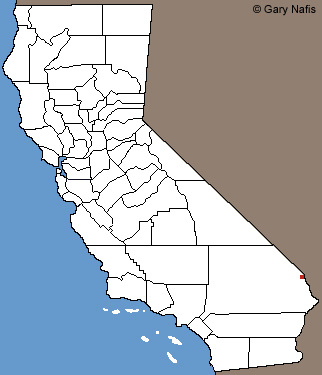|
Formerly present, possibly extirpated in California.
All toads shown here were found outside California.
|
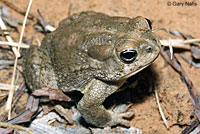 |
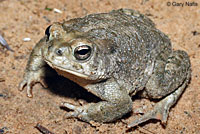 |
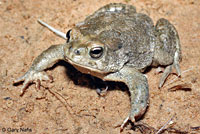 |
| Adult, Washington County, Utah |
Adult, Washington County, Utah |
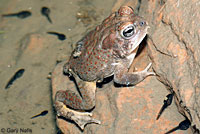 |
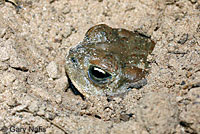 |
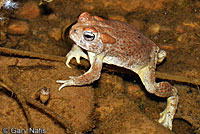 |
| Adult, Washington County, Utah |
Adult, emerging from the sand at sunset, Washington County, Utah |
Adult, Washington County, Utah |
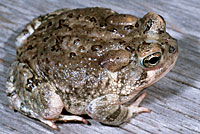 |
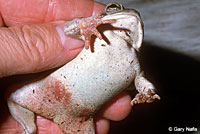 |
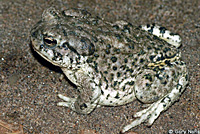 |
| Adult, Yavapai County, Arizona |
Adult, Arizona. Arizona-Sonora
Desert Museum
|
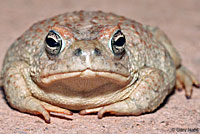 |
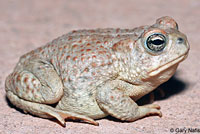 |
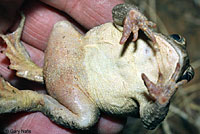 |
Adult, Washington County, Utah
|
Underside of adult |
| |
|
| Juveniles |
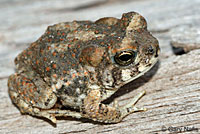 |
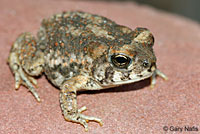 |
|
Juvenile, Washington County, Utah
|
|
| |
|
| Possible California Habitat |
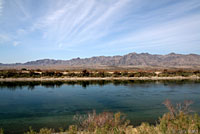 |
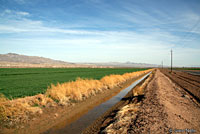 |
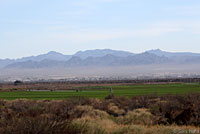 |
Possible habitat along the Colorado River near Needles, San Bernardino County
|
Possible habitat near the Colorado River near Fort Mojave, San Bernardino County |
| |
|
| Short Videos |
 |
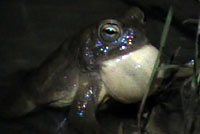 |
 |
Several male Arizona Toads calling and interacting at night at the edge of a small creek next to a river in Washington County, Utah, including two examples of a male attempting amplexus with another male who then makes release calls. Canyon Treefrogs can be heard in the background.
|
A short example of a male calling at night. |
Several Arizona Toads seen hanging around the edge of a small creek at night in Washington County, Utah. |
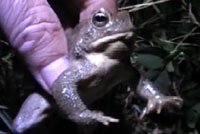 |
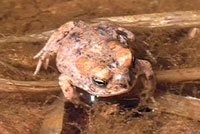 |
|
A male gives a release call
when he is picked up. |
Tiny recently-metamorphosed toadlets hop and swim around a breeding creek full of tadpoles of several species of frogs and toads. |
|
| |
|
|
|
Description |
| |
| Size |
Adults are 1.8 - 3.4 inches from snout to vent (4.6 - 8.6 cm). (Stebbins, 2003)
|
| Appearance |
| A plump, stocky toad with dry, skin with low warts and few tubercles. No cranial crests. Oval, widely separated parotoid glands that are pale toward the front. Pupils are horizontal. |
| Color and Pattern |
Color is usually gray, but can be beige, pale yellow, pink, rusty, and brown.
There is no stripe down the middle of the back.
Often paler on front of parotoids, upper eyelids, and central upper back.
Whitish below, with no spots or mottling.
Male and female throats are pale.
(Has fewer warts and spots and tubercles than related A. californicus.) |
| Young |
Young are salmon-colored or light olive with reddish warts.
|
| Life History and Behavior |
| Activity |
| Nocturnally active, remaining underground in the daytime, but occasionally seen moving about in daylight or resting at the edge of breeding pools in the breeding season. |
| Movement |
| Moves by hopping instead of walking. |
| Defense |
| Like most toads do for defense, this toad relies on parotoid glands and warts which can secrete a poison that deters some predators. |
| Longevity |
| Probably 4 - 5 years. |
| Voice (Listen) |
A loud, fast high-pitched trill averaging 5.7 seconds in length, rising in pitch, and ending abruptly. Calls are made at night.
|
| Diet and Feeding |
Diet consists of a variety of invertebrates.
Prey is located by vision, then the toad lunges with a large sticky tongue to catch the prey and bring it into the mouth to eat. |
| Reproduction |
Reproduction is aquatic.
Fertilization is external, with the male grasping the back of the female and releasing sperm as the female lays her eggs.
Amplexus is axillary - the male grabs the female around her shoulders or armpits.
The reproductive cycle is similar to that of most North American Frogs and Toads. Mature adults come into breeding condition and migrate to ponds or ditches where the males call to advertise their fitness to competing males and to females. Males and females pair up in amplexus in the water where the female lays her eggs as the male fertilizes them externally. The adults leave the water and the eggs hatch into tadpoles which feed in the water and eventually grow four legs, lose their tails and emerge onto land where they disperse into the surrounding territory.
Breeding takes place from early to Late February at some locations, and late March to early April at higher-elevation locations, ending as late as July. Breeding is not dependent on rainfall, but by warming temperatures and water levels. Spring flooding delays breeding. Breeding may occur for 10 - 12 days at a location, then stop due to rain and floods, and continue again following warmer drier weather.
Breeding sites are shallow stream edges and side pools with minimal current. Males gather at a breeding site and make an advertisement call to attract females, but many males are satellite breeders, either searching for females, or waiting and grabbing a female who is attracted to another male's call.
|
| Eggs |
Egg strings are laid on the bottom of pools.
An average of 4,500 eggs per clutch has been estimated. (Schwaner and Sullivan in Lanoo, 2005)
Eggs hatch in 3 - 6 days. |
| Tadpoles and Young |
Tadpoles undergo metamorphosis 3 - 4 months after hatching, depending on varying environmental conditions.
Predation and flooding can cause high tadpole mortality.
|
| Hybrids |
Hybridizes with A. woodhousii in some areas.
|
| Habitat |
Inhabits riparian areas from lowlands near
the Colorado River drainage in California, into uplands and pine-oak woodland.
|
| Geographical Range |
The overall range of this toad is fragmented, from the Colorado River drainage near Fort Mojave, east across central Arizona into western New Mexico, and around the area where the Nevada, Utah, and Arizona borders meet.
In his 1972 book California Amphibians and Reptiles, Robert Stebbins states that this toad is present at the Colorado River near Needles, but I have not yet found any records of museum specimens from that area of California. In the range map of his subsequent 2003 field guide, Stebbins does not indicate that B. microsacphus occurs (or even formerly occured) in California. Many sources do show the range of this toad extending into California, as in this US Forest Service map, and this IUCN map.
I list the species as formerly present in California due to these and other indications of its occurrence in California across the Colorado River from known populations around Fort Mojave, Arizona. More recent range maps which do not show this species occurring in California are interpreted as illustrating that the species no longer occurs in the state due to habitat alteration.
|
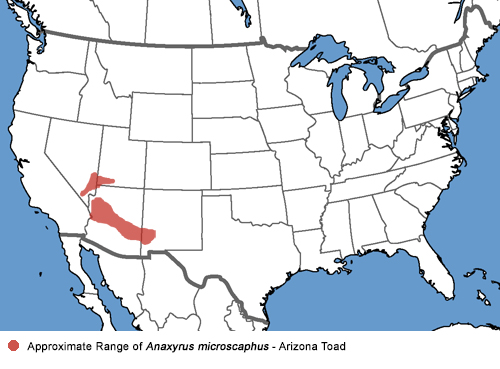 |
| Elevational Range |
From 600 - 6,000 ft. (190 - 1,829 m.) (Stebbins, 2003)
|
| Notes on Taxonomy |
| In 1998 B. microscaphus was split into two species, B. californicus, and B. microscaphus. Some sources still list this toad as a subspecies of Bufo microscaphus, Bufo microscaphus microscaphus.
--------------------------------------------------------------------------------------------------------------------------------------------------------------------
Formerly included in the genus Bufo. In 2006, Frost et al replaced the long-standing genus Bufo in North America with Anaxyrus, restricting Bufo to the eastern hemisphere. Bufo is still used in many existing references.
--------------------------------------------------------------------------------------------------------------------------------------------------------------------
Nicholson, K. E. (ed.). 2025 SSAR Scientific and Standard English Names List:
Hybridizes extensively with A. woodhousii in portions of its range (e.g., Wooten et al., 2019, Journal of Herpetology, 53: 104–114.
--------------------------------------------------------------------------------------------------------------------------------------------------------------------
Alternate and Previous Names (Synonyms)
Fort Mojave Toad
Bufo microscaphus - Arizona Toad (Stebbins 2003)
Bufo microscaphus microscaphus - Arizona Toad (Stebbins1954, 1966, 1985)
|
| Conservation Issues (Conservation Status) |
| I can't find any information about the current presence and status of this toad in California. It has been estimated to be absent from 75% of its historic range, but others note that a general decline has not occurred throughout Arizona. Impoundments which restrict the flow of stream water, create quiet waters which are more favored for breeding by a competing toad species, A. woodhousii, with which A. microscaphus hybridizes. Introduced predators, land alteration, and human recreational land use may also contribute to declines. |
|
| Taxonomy |
| Family |
Bufonidae |
True Toads |
Gray, 1825 |
| Genus |
Anaxyrus |
North American Toads |
Tschudi, 1845 |
| Species |
microscaphus |
Arizona Toad
|
(Cope, 1866) |
|
Original Description |
Cope, "1866" 1867 - Proc. Acad. Nat. Sci. Philadelphia, Vol. 18, Oct., p. 301
from Original Description Citations for the Reptiles and Amphibians of North America © Ellin Beltz
|
|
Meaning of the Scientific Name |
Anaxyrus - Greek = A king or chief
microscaphus - refers to this toad's small tarsal spade
Greek - mikros = small
Greek - skaphis = spade or shovel
Taken in part from Scientific and Common Names of the Reptiles and Amphibians of North America - Explained © Ellin Beltz
|
|
Related or Similar California Frogs |
Anaxyrus californicus - Arroyo Toad
|
|
More Information and References |
California Department of Fish and Wildlife
AmphibiaWeb
Hansen, Robert W. and Shedd, Jackson D. California Amphibians and Reptiles. (Princeton Field Guides.) Princeton University Press, 2025.
Stebbins, Robert C., and McGinnis, Samuel M. Field Guide to Amphibians and Reptiles of California: Revised Edition (California Natural History Guides) University of California Press, 2012.
Stebbins, Robert C. California Amphibians and Reptiles. The University of California Press, 1972.
Flaxington, William C. Amphibians and Reptiles of California: Field Observations, Distribution, and Natural History. Fieldnotes Press, Anaheim, California, 2021.
Nicholson, K. E. (ed.). 2025. Scientific and Standard English Names of Amphibians and Reptiles of North America North of Mexico, with Comments Regarding Confidence in Our Understanding. Ninth Edition. Society for the Study of Amphibians and Reptiles. [SSAR] 87pp.
Samuel M. McGinnis and Robert C. Stebbins. Peterson Field Guide to Western Reptiles & Amphibians. 4th Edition. Houghton Mifflin Harcourt Publishing Company, 2018.
Stebbins, Robert C. A Field Guide to Western Reptiles and Amphibians. 3rd Edition. Houghton Mifflin Company, 2003.
Behler, John L., and F. Wayne King. The Audubon Society Field Guide to North American Reptiles and Amphibians. Alfred A. Knopf, 1992.
Robert Powell, Roger Conant, and Joseph T. Collins. Peterson Field Guide to Reptiles and Amphibians of Eastern and Central North America. Fourth Edition. Houghton Mifflin Harcourt, 2016.
Powell, Robert., Joseph T. Collins, and Errol D. Hooper Jr. A Key to Amphibians and Reptiles of the Continental United States and Canada. The University Press of Kansas, 1998.
Davidson, Carlos. Booklet to the CD Frog and Toad Calls of the Pacific Coast - Vanishing Voices. Cornell Laboratory of Ornithology, 1995. |
|
|
The following conservation status listings for this animal are taken from the July 2025 State of California Special Animals List and the July 2025 Federally Listed Endangered and Threatened Animals of California list (unless indicated otherwise below.) Both lists are produced by multiple agencies every year, and sometimes more than once per year, so the conservation status listing information found below might not be from the most recent lists, but they don't change a great deal from year to year.. To make sure you are seeing the most recent listings, go to this California Department of Fish and Wildlife web page where you can search for and download both lists:
https://www.wildlife.ca.gov/Data/CNDDB/Plants-and-Animals.
A detailed explanation of the meaning of the status listing symbols can be found at the beginning of the two lists. For quick reference, I have included them on my Special Status Information page.
If no status is listed here, the animal is not included on either list. This most likely indicates that there are no serious conservation concerns for the animal. To find out more about an animal's status you can also go to the NatureServe and IUCN websites to check their rankings.
Check the current California Department of Fish and Wildlife sport fishing regulations to find out if this animal can be legally pursued and handled or collected with possession of a current fishing license. You can also look at the summary of the sport fishing regulations as they apply only to reptiles and amphibians that has been made for this website.
This toad is not on the Special Animals List, meaning there are no significant conservation concerns for it in California according to the Dept. of Fish and Game. However, this might be because they do not recognize it as a distinct species. If it still occurs in California, this toad is definitely at risk.
|
| Organization |
Status Listing |
Notes |
| NatureServe Global Ranking |
|
|
| NatureServe State Ranking |
|
|
| U.S. Endangered Species Act (ESA) |
None |
|
| California Endangered Species Act (CESA) |
None |
|
| California Department of Fish and Wildlife |
None |
|
| Bureau of Land Management |
None |
|
| USDA Forest Service |
None |
|
| IUCN |
|
|
|
|
|
